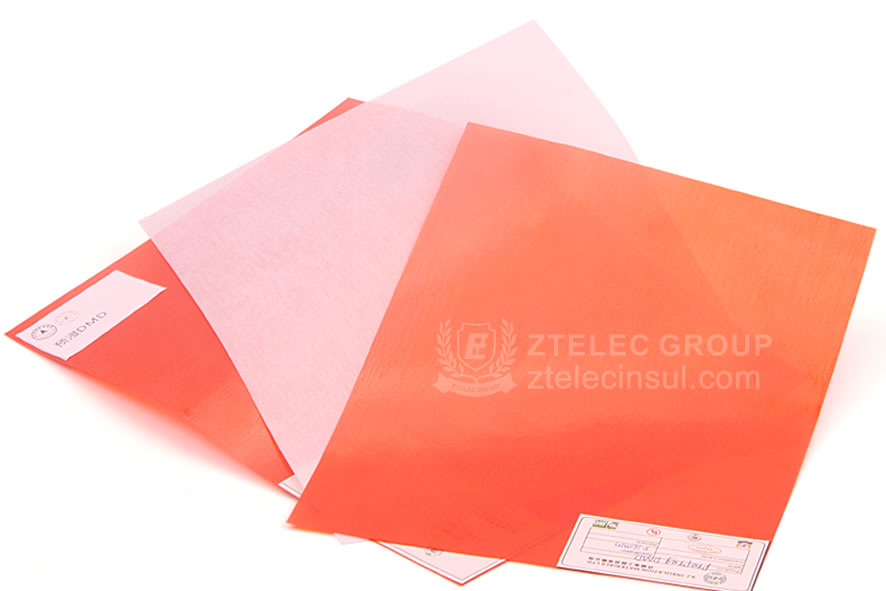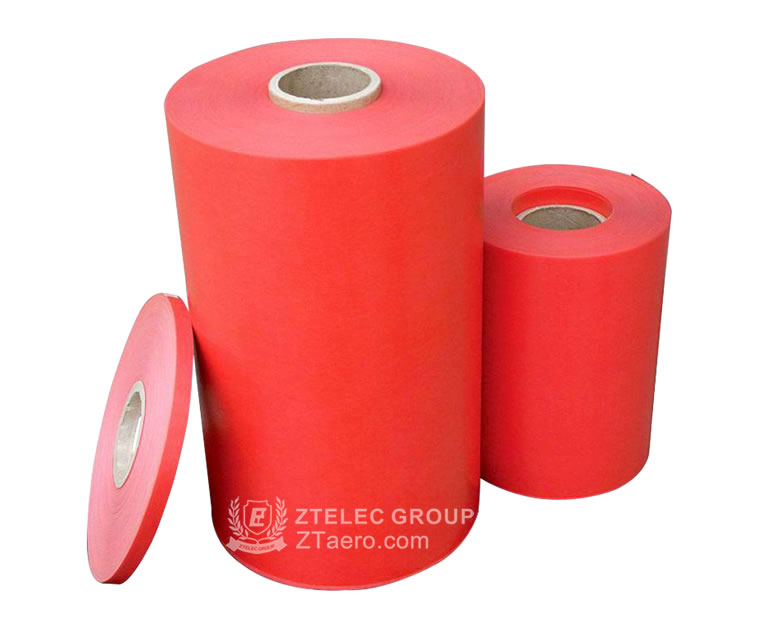DMD insulation paper is a high-performance insulation material composed of three layers of materials. Its name comes ...
DMD insulation paper is a high-performance insulation material composed of three layers of materials. Its name comes from its structural composition: the upper and lower layers are polyester fiber non-woven fabrics, and the middle layer is polyester film (Mylar, PET film), which is compounded by high-temperature resistant adhesives. This design combines the mechanical strength and impregnation properties of polyester fiber and the high dielectric properties of polyester film, while also having excellent heat resistance, dimensional stability and chemical corrosion resistance.

Insulation class: B/F class (130°C/155 °C)
Color: Blue, green, white and pink
Width: 10-1000mm
Thickness: 0.13-0.35mm
*Can be customized
DMD insulation paper is widely used in insulation protection in the fields of motors, transformers, generators, electrical equipment, etc., such as as motor slot insulation, transformer interlayer insulation or isolation material for electronic components. Its temperature resistance grade is usually B class (130℃), F class (155℃) or higher, which can adapt to different working conditions. With balanced electrical properties, mechanical strength and easy processing, DMD insulation paper has become a commonly used material in industrial electrical insulation.
About our DMD insulation paper, it is available in a selection of thicknesses. DMD’s construction ensures it provides good electrical strength. Specific breakdown voltage ratings vary depending on overall thickness, you can choose you need according the parameters on the chart:
| Number | Name | Unit | Value | ||||||||
| 1 | Nominal Thickness | mm | 0.13 | 0.15 | 0.18 | 0.2 | 0.23 | 0.25 | 0.3 | 0.35 | |
| 2 | Thickness Tolerance | mm | ±0.02 | ±0.02 | ±0.02 | ±0.02 | ±0.02 | ±0.02 | ±0.03 | ±0.03 | |
| 3 | Nominal Quantification | g/cm2 | 130±15 | 145±20 | 180±20 | 220±20 | 255±30 | 285±30 | 350±30 | 425±40 | |
| 4 | Nominal Film Thickness | um | 36 | 50 | 75 | 100 | 125 | 150 | 188 | 250 | |
| 5 | Tensile Strength | Crosswise | N/10mm | ≥60 | ≥90 | ≥120 | ≥140 | ≥180 | ≥190 | ≥270 | ≥320 |
| Lengthwise | ≥40 | ≥80 | ≥105 | ≥120 | ≥150 | ≥170 | ≥200 | ≥300 | |||
| 6 | Elongation | Crosswise | % | ≥15 | ≥5 | ||||||
| Lengthwise | ≥20 | ≥5 | |||||||||
| 7 | Breakdown Voltage | Non-bending | KV | ≥4.0 | ≥6.0 | ≥7.0 | ≥9.0 | ≥10 | ≥12 | ≥15 | ≥18 |
| ≥5.0 | ≥7.0 | ≥8.0 | ≥10 | ≥11 | ≥13 | ≥16 | ≥19 | ||||
| After Bending | ≥3.0 | ≥5.0 | ≥6.0 | ≥8.0 | ≥9.0 | ≥11 | ≥13 | ≥18 | |||
| ≥3.5 | ≥6.0 | ≥7.0 | ≥9.0 | ≥10 | ≥11 | ≥14 | ≥18 | ||||
| 8 | Thermal Index | – | 130、155 | ||||||||
| 9 | Adhesion under Normal | – | No Delamination | ||||||||
| 10 | Adhesion at Heat(130-155±2℃-10min) | – | No Delamination, No foaming, No Flowing Glue | ||||||||
DMD insulation paper and pre-impregnated DMD (Pre-impregnated DMD) are two commonly used materials in the field of electrical insulation. Although the names are similar, there are significant differences in their composition, processing technology and application scenarios.

The following are the main differences between the two:
DMD insulation paper:
It consists of three layers: the upper and lower layers are polyester fiber non-woven fabrics, and the middle layer is a polyester film, which is compounded by an adhesive. It is not impregnated with any resin and needs to be used with impregnating paint (such as epoxy resin, polyester paint) in subsequent processing (such as motor windings).
Pre-impregnated DMD:
On the basis of ordinary DMD insulation paper, thermosetting resin (such as epoxy resin or phenolic resin) is pre-impregnated. The resin is in a semi-cured state (B-stage), and the final curing (C-stage) is completed by heating and pressurizing when used.
Performance characteristics comparison
DMD insulation paper:
Advantages: good flexibility, easy to punch and fold; compatible with a variety of impregnating paints, suitable for complex insulation structures.
Limitations: Depends on the subsequent impregnation process. If the impregnation is not sufficient, the insulation performance may be affected.
Pre-impregnated DMD:
Advantages:
The resin is evenly distributed, and the mechanical strength after curing is higher (such as tear resistance and puncture resistance);
After curing, a dense insulation layer is formed, which has better moisture resistance and chemical corrosion resistance;
The dielectric properties are more stable and suitable for high-frequency or high-voltage environments.
Limitations:
The flexibility is low, and repeated bending should be avoided during processing to prevent the resin layer from cracking.
DMD insulation paper and pre-impregnated DMD comparison table
| Criteria | DMD Insulation Paper | Pre-impregnated DMD |
| Composition | Pure DMD layers | DMD + pre-impregnated resin |
| Processing | Requires impregnation + curing | Heat/pressure curing |
| Performance | Flexible, cost-effective | High strength, chemical resistance |
| Applications | Traditional motors, low-voltage devices | High-frequency/high-voltage systems |
Select based on requirements (temperature class, production efficiency, cost). For critical applications, validate parameters with suppliers (e.g., UL certification, arc resistance testing).
ZTelec Group is a professional manufacturer of high-quality electrical insulation materials, integrating the research and development, production and sales of electrical and electrical insulation materials. It has more than 65 years of manufacturing experience. The production capacity and market share of insulation materials are ranked top three in the industry, and special insulation materials are ranked first.
If you need to know more about DMD insulation Paper and other insulation materials product information and quotations,
please contact us, we can mail you samples for your testing
Welcome to visit our factory for guidance.
If you are interested in our products,, please send us a message and we will contact you as soon as we receive it. Email: info@ztaero.com whatsApp: +8616650273778